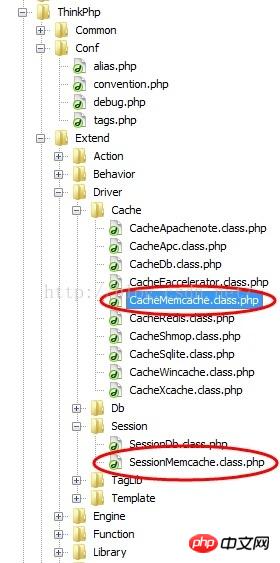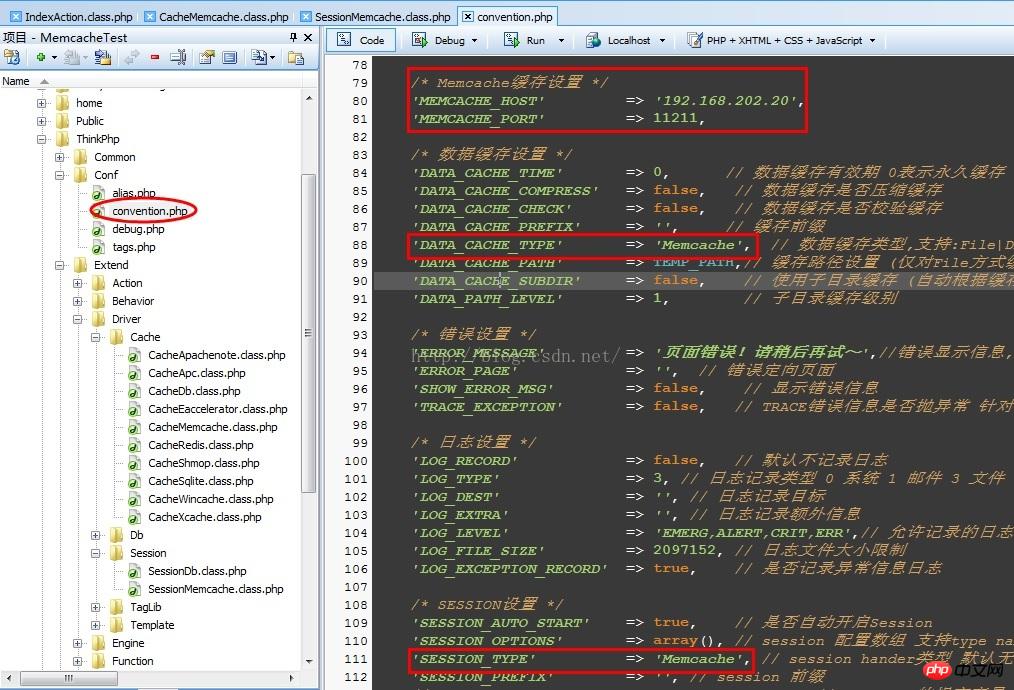 Backend Development
Backend Development
 PHP Tutorial
PHP Tutorial
 Detailed explanation of distributed deployment examples of ThinkPHP project
Detailed explanation of distributed deployment examples of ThinkPHP project
Detailed explanation of distributed deployment examples of ThinkPHP project
In ordinary Web development, the common mode is that after the user logs in, the login status information is stored in the Session, some of the user's commonly used hot data is stored in the file cache, and the attachment information uploaded by the user is stored in a directory on the Web server. . This method is very convenient to use and fully capable for general Web applications. But for high-concurrency enterprise-level websites, it cannot handle it. Web clusters need to be used to achieve load balancing.
After deploying using the Web cluster method, the first thing to adjust is the user status information and attachment information. User status can no longer be saved to the Session, the cache cannot use the file cache of the local Web server, and attachments cannot be saved on the Web server. Because it is necessary to ensure that the status of each web server in the cluster is completely consistent. Therefore, user status, cache, etc. need to be saved to a dedicated cache server, such as Memcache. Attachments need to be saved to cloud storage, such as Qiniu Cloud Storage, Alibaba Cloud Storage, Tencent Cloud Storage, etc.
This article takes the ThinkPHP development framework as an example to explain how to set up and save Session, cache, etc. to the Memcache cache server.
Download the cached Memcache processing class and place it in the Thinkphp\Extend\Driver\Cache directory; download the Session Memcache processing class and place it in the Thinkphp\Extend\Driver\Session directory. As shown in the figure below:

Modify the configuration file, adjust the Session and cache, and record them to the Memcache server. Open ThinkPHP\Conf\convention.php, add configuration items:
/* Memcache缓存设置 */
'MEMCACHE_HOST' => '192.168.202.20',
'MEMCACHE_PORT' => 11211,Modify the data cache to Memcache:
'DATA_CACHE_TYPE' => 'Memcache',
Modify the Session to Memcache:
'SESSION_TYPE' => 'Memcache',
As shown in the figure below:

# Because there are many types of cloud storage, attachments are stored on cloud storage, so I won’t go into details. Just parameterize the SDK provided by each cloud storage. After the above modifications, the Web server can be deployed in a distributed manner.
Attachment 1: CacheMemcache.class.php
<?php
// +----------------------------------------------------------------------
// | ThinkPHP [ WE CAN DO IT JUST THINK IT ]
// +----------------------------------------------------------------------
// | Copyright (c) 2006-2012 http://thinkphp.cn All rights reserved.
// +----------------------------------------------------------------------
// | Licensed ( http://www.apache.org/licenses/LICENSE-2.0 )
// +----------------------------------------------------------------------
// | Author: liu21st <liu21st@gmail.com>
// +----------------------------------------------------------------------
defined('THINK_PATH') or exit();
/**
* Memcache缓存驱动
* @category Extend
* @package Extend
* @subpackage Driver.Cache
* @author liu21st <liu21st@gmail.com>
*/
class CacheMemcache extends Cache {
/**
* 架构函数
* @param array $options 缓存参数
* @access public
*/
function __construct($options=array()) {
if ( !extension_loaded('memcache') ) {
throw_exception(L('_NOT_SUPPERT_').':memcache');
}
$options = array_merge(array (
'host' => C('MEMCACHE_HOST') ? C('MEMCACHE_HOST') : '127.0.0.1',
'port' => C('MEMCACHE_PORT') ? C('MEMCACHE_PORT') : 11211,
'timeout' => C('DATA_CACHE_TIMEOUT') ? C('DATA_CACHE_TIMEOUT') : false,
'persistent' => false,
),$options);
$this->options = $options;
$this->options['expire'] = isset($options['expire'])? $options['expire'] : C('DATA_CACHE_TIME');
$this->options['prefix'] = isset($options['prefix'])? $options['prefix'] : C('DATA_CACHE_PREFIX');
$this->options['length'] = isset($options['length'])? $options['length'] : 0;
$func = $options['persistent'] ? 'pconnect' : 'connect';
$this->handler = new Memcache;
$options['timeout'] === false ?
$this->handler->$func($options['host'], $options['port']) :
$this->handler->$func($options['host'], $options['port'], $options['timeout']);
}
/**
* 读取缓存
* @access public
* @param string $name 缓存变量名
* @return mixed
*/
public function get($name) {
N('cache_read',1);
return $this->handler->get($this->options['prefix'].$name);
}
/**
* 写入缓存
* @access public
* @param string $name 缓存变量名
* @param mixed $value 存储数据
* @param integer $expire 有效时间(秒)
* @return boolen
*/
public function set($name, $value, $expire = null) {
N('cache_write',1);
if(is_null($expire)) {
$expire = $this->options['expire'];
}
$name = $this->options['prefix'].$name;
if($this->handler->set($name, $value, 0, $expire)) {
if($this->options['length']>0) {
// 记录缓存队列
$this->queue($name);
}
return true;
}
return false;
}
/**
* 删除缓存
* @access public
* @param string $name 缓存变量名
* @return boolen
*/
public function rm($name, $ttl = false) {
$name = $this->options['prefix'].$name;
return $ttl === false ?
$this->handler->delete($name) :
$this->handler->delete($name, $ttl);
}
/**
* 清除缓存
* @access public
* @return boolen
*/
public function clear() {
return $this->handler->flush();
}
}Attachment 2: SessionMemcache.class.php
<?php
// +----------------------------------------------------------------------
// |
// +----------------------------------------------------------------------
// | Copyright (c) 2013-
// +----------------------------------------------------------------------
// | Licensed ( http://www.apache.org/licenses/LICENSE-2.0 )
// +----------------------------------------------------------------------
// | Author: richievoe <richievoe@163.com>
// +----------------------------------------------------------------------
/**
* 自定义Memcache来保存session
*/
Class SessionMemcache{
//memcache对象
private $mem;
//SESSION有效时间
private $expire;
//外部调用的函数
public function execute(){
session_set_save_handler(
array(&$this,'open'),
array(&$this,'close'),
array(&$this,'read'),
array(&$this,'write'),
array(&$this,'destroy'),
array(&$this,'gc')
);
}
//连接memcached和初始化一些数据
public function open($path,$name){
$this->expire = C('SESSION_EXPIRE') ? C('SESSION_EXPIRE') :ini_get('session.gc_maxlifetime');
$this->mem = new Memcache;
return $this->mem->connect(C('MEMCACHE_HOST'), C('MEMCACHE_PORT'));
}
//关闭memcache服务器
public function close(){
return $this->mem->close();
}
//读取数据
public function read($id){
$id = C('SESSION_PREFIX').$id;
$data = $this->mem->get($id);
return $data ? $data :'';
}
//存入数据
public function write($id,$data){
$id = C('SESSION_PREFIX').$id;
//$data = addslashes($data);
return $this->mem->set($id,$data,0,$this->expire);
}
//销毁数据
public function destroy($id){
$id = C('SESSION_PREFIX').$id;
return $this->mem->delete($id);
}
//垃圾销毁
public function gc(){
return true;
}
}
?>After the above configuration, user status information and cache information can be saved into Memcache. You can use load balancing servers to build websites in large-scale clusters.
Related recommendations:
Talk in detail about PHP distributed deployment
##MongoDB stand-alone, master-slave, distributed deployment
PHP extended Memcache distributed deployment solution_PHP
The above is the detailed content of Detailed explanation of distributed deployment examples of ThinkPHP project. For more information, please follow other related articles on the PHP Chinese website!

Hot AI Tools

Undresser.AI Undress
AI-powered app for creating realistic nude photos

AI Clothes Remover
Online AI tool for removing clothes from photos.

Undress AI Tool
Undress images for free

Clothoff.io
AI clothes remover

Video Face Swap
Swap faces in any video effortlessly with our completely free AI face swap tool!

Hot Article

Hot Tools

Notepad++7.3.1
Easy-to-use and free code editor

SublimeText3 Chinese version
Chinese version, very easy to use

Zend Studio 13.0.1
Powerful PHP integrated development environment

Dreamweaver CS6
Visual web development tools

SublimeText3 Mac version
God-level code editing software (SublimeText3)

Hot Topics
 1664
1664
 14
14
 1423
1423
 52
52
 1317
1317
 25
25
 1268
1268
 29
29
 1246
1246
 24
24
 Explain JSON Web Tokens (JWT) and their use case in PHP APIs.
Apr 05, 2025 am 12:04 AM
Explain JSON Web Tokens (JWT) and their use case in PHP APIs.
Apr 05, 2025 am 12:04 AM
JWT is an open standard based on JSON, used to securely transmit information between parties, mainly for identity authentication and information exchange. 1. JWT consists of three parts: Header, Payload and Signature. 2. The working principle of JWT includes three steps: generating JWT, verifying JWT and parsing Payload. 3. When using JWT for authentication in PHP, JWT can be generated and verified, and user role and permission information can be included in advanced usage. 4. Common errors include signature verification failure, token expiration, and payload oversized. Debugging skills include using debugging tools and logging. 5. Performance optimization and best practices include using appropriate signature algorithms, setting validity periods reasonably,
 Explain late static binding in PHP (static::).
Apr 03, 2025 am 12:04 AM
Explain late static binding in PHP (static::).
Apr 03, 2025 am 12:04 AM
Static binding (static::) implements late static binding (LSB) in PHP, allowing calling classes to be referenced in static contexts rather than defining classes. 1) The parsing process is performed at runtime, 2) Look up the call class in the inheritance relationship, 3) It may bring performance overhead.
 What are PHP magic methods (__construct, __destruct, __call, __get, __set, etc.) and provide use cases?
Apr 03, 2025 am 12:03 AM
What are PHP magic methods (__construct, __destruct, __call, __get, __set, etc.) and provide use cases?
Apr 03, 2025 am 12:03 AM
What are the magic methods of PHP? PHP's magic methods include: 1.\_\_construct, used to initialize objects; 2.\_\_destruct, used to clean up resources; 3.\_\_call, handle non-existent method calls; 4.\_\_get, implement dynamic attribute access; 5.\_\_set, implement dynamic attribute settings. These methods are automatically called in certain situations, improving code flexibility and efficiency.
 PHP and Python: Comparing Two Popular Programming Languages
Apr 14, 2025 am 12:13 AM
PHP and Python: Comparing Two Popular Programming Languages
Apr 14, 2025 am 12:13 AM
PHP and Python each have their own advantages, and choose according to project requirements. 1.PHP is suitable for web development, especially for rapid development and maintenance of websites. 2. Python is suitable for data science, machine learning and artificial intelligence, with concise syntax and suitable for beginners.
 PHP in Action: Real-World Examples and Applications
Apr 14, 2025 am 12:19 AM
PHP in Action: Real-World Examples and Applications
Apr 14, 2025 am 12:19 AM
PHP is widely used in e-commerce, content management systems and API development. 1) E-commerce: used for shopping cart function and payment processing. 2) Content management system: used for dynamic content generation and user management. 3) API development: used for RESTful API development and API security. Through performance optimization and best practices, the efficiency and maintainability of PHP applications are improved.
 PHP: A Key Language for Web Development
Apr 13, 2025 am 12:08 AM
PHP: A Key Language for Web Development
Apr 13, 2025 am 12:08 AM
PHP is a scripting language widely used on the server side, especially suitable for web development. 1.PHP can embed HTML, process HTTP requests and responses, and supports a variety of databases. 2.PHP is used to generate dynamic web content, process form data, access databases, etc., with strong community support and open source resources. 3. PHP is an interpreted language, and the execution process includes lexical analysis, grammatical analysis, compilation and execution. 4.PHP can be combined with MySQL for advanced applications such as user registration systems. 5. When debugging PHP, you can use functions such as error_reporting() and var_dump(). 6. Optimize PHP code to use caching mechanisms, optimize database queries and use built-in functions. 7
 The Enduring Relevance of PHP: Is It Still Alive?
Apr 14, 2025 am 12:12 AM
The Enduring Relevance of PHP: Is It Still Alive?
Apr 14, 2025 am 12:12 AM
PHP is still dynamic and still occupies an important position in the field of modern programming. 1) PHP's simplicity and powerful community support make it widely used in web development; 2) Its flexibility and stability make it outstanding in handling web forms, database operations and file processing; 3) PHP is constantly evolving and optimizing, suitable for beginners and experienced developers.
 Explain the match expression (PHP 8 ) and how it differs from switch.
Apr 06, 2025 am 12:03 AM
Explain the match expression (PHP 8 ) and how it differs from switch.
Apr 06, 2025 am 12:03 AM
In PHP8, match expressions are a new control structure that returns different results based on the value of the expression. 1) It is similar to a switch statement, but returns a value instead of an execution statement block. 2) The match expression is strictly compared (===), which improves security. 3) It avoids possible break omissions in switch statements and enhances the simplicity and readability of the code.



